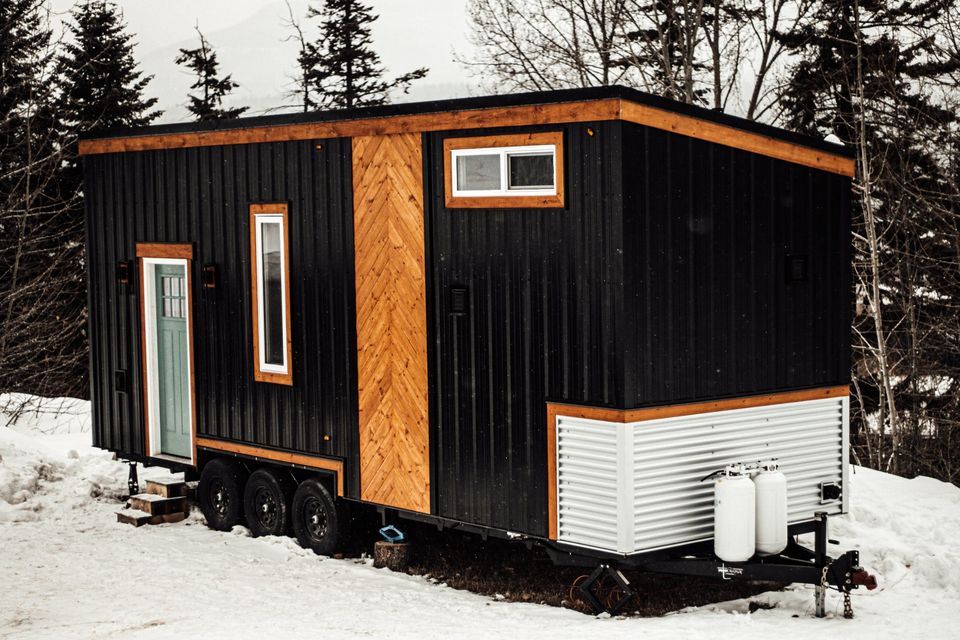Tiny House Ventilation
According to the BC Tiny House Collective, tiny houses are a special category of compact, non-motorized buildings that may be permanent or mobile and feature indoor space footprint of less than 500 square feet. Tiny houses are gaining widespread acceptance mainly due to their affordability, simplicity, and sustainability. However, it should be noted that several tiny houses are not designed with dedicated ventilation systems and may therefore be susceptible to the accumulation of moisture, pollutants, and odors. Additionally, there are limited resources that specifically address the ventilation requirements of tiny houses. In this article, we briefly explain effective ventilation strategies for tiny houses.
CSA Z240 Certified Tiny House on Wheels; Built in Golden, British Columbia.*

Local Ventilation
Due to the relatively small space footprint of tiny houses, exhaust fans are sometimes installed in the bathrooms / kitchens (or similar spaces) to expel the stale air stream while fresh air is supplied through crevices in an indoor space or by opening the window(s) and / or door(s). Although local ventilation is preferable to none, the main challenge with an exhaust-only system (which is prevalent in cold climates) is the tendency for the depressurization of the space and lack of adequate fresh air replacement. Supply-only local ventilation may over pressurize the space and may not remove the pollutants at a controlled rate. Moreover, local ventilation systems may not offer energy savings because the additional energy that is used to condition the space due to ventilation losses is not recovered. Some local ventilation units may require the use of ducting while others may be directed vented to the outdoors (e.g., through-wall exhaust fans).
AccuraSEE offers compact energy-efficient ventilation fans which may be used to provide continuous or intermittent ventilation of ≥20 CFM (9.4 L/s) while consuming as little as 1 W. Interestingly, the cost of running our ventilation fans starts from less than $2 per year!
AccuraSEE MINI in a CSA Z240 Certified Tiny House on Wheels. The MINI unit, which is installed in the main area of the house, is highlighted with a green oval.*

Whole House Ventilation
The ventilation of the whole house is preferred, and this approach can feature the use of exhaust / supply fans or balanced ventilation equipment which are also called heat or energy recovery ventilators (H/ERVs). We will focus on H/ERVs which are the preferred equipment for ventilating buildings because they ensure that fresh air is supplied and stale air is exhausted while keeping the pressure in the indoor space balanced. Importantly, heat and/or moisture can be transferred between the supply and exhaust air streams thereby reducing the overall energy consumption for conditioning the space.
Ductless Heat or Energy Recovery Ventilators
Ductless H/ERV units are widely used to provide balanced ventilation in tiny houses. Most ductless H/ERVs utilize regenerative heat exchangers which absorb and release heat in periodic cycles. In a cycle, heat is accumulated in a solid structure when exposed to a relatively warm air stream and then released to a relatively colder air stream in the subsequent cycle. Some regenerative heat exchangers may feature a solid structure that is coated with a desiccant for both heat and moisture recovery. The desiccant, which has a high affinity for moisture, absorbs water vapor from a more humid air stream in one cycle and releases the moisture to a dryer air stream in the next cycle. It should, however, be noted that some ductless H/ERVs utilize recuperative heat exchangers.
Ductless HRVs are typically installed through the wall and often operate in pairs where one unit supplies fresh air to the space whereas the other unit expels stale air at a given point in time. The main advantages of ductless HRVs are their compactness and relatively high efficiencies. However, they can suffer poor heat recovery efficiency in the presence of strong wind drafts or stack effect and are also susceptible to odor and pollutant transfer between the supply and exhaust air streams which can reduce the indoor air quality.
Ducted Heat or Energy Recovery Ventilators
Ducted H/ERV units are also used for ventilation in tiny houses and may be installed as a centralized unit in the utility room, mounted in the ceiling, or in portable formats like MINI. Most ducted H/ERVs utilize recuperative heat exchangers which facilitate instantaneous heat exchange between supply and exhaust air streams. They exhibit moderate to high efficiencies and, unlike ductless units, do limit the crossover of pollutants between the air streams. In addition, their fans are often sized to handle moderate to high static pressures and their heat exchange capability is not impacted by wind drafts. Nevertheless, the main limitation of ducted H/ERV units is their relatively high space footprint for installation and susceptibility to frosting at sub-zero temperatures.
At AccuraSEE, our thermal energy recovery units overcome the limitations of conventional units because, similar to portable air conditioners, they can be easily self-installed in multiple sites such as windows, walls, doors, and ceilings. In addition, our units are built to prevent and mitigate the impact of frosting even at temperatures below –20ºC [–4ºF ].
Bibliography
- Alonso, M. J., Liu, P., Mathisen, H. M., Ge, G. and Simonson, C. (2015) “Review of Heat/Energy Recovery Exchangers for Use in ZEBs in Cold Climate Countries.” Building and Environment. 84:228-237.
- ANSI/ASHRAE (2019) “Standard 62.2. Ventilation and Acceptable Indoor Air Quality in Low-Rise Residential Buildings.” ASHRAE, Inc., Atlanta, GA.
- BC Housing (2021) “Tiny Homes – An Alternative to Conventional Housing.” BC Housing Research Center, Burnaby, Canada.
- Merzkirch, A., Maas, S., Scholzen, F. and Waldmann, D. (2016) “Field Tests of Centralized and Decentralized Ventilation Units in Residential Buildings – Specific Fan Power, Heat Recovery Efficiency, Shortcuts and Volume Flow Unbalances.” Building and Environment. 116:376-383.
We offer diverse products for a wide range of customers and applications…
*Courtesy of Oliver E.